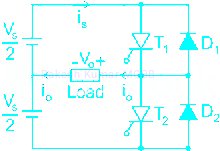The modified McMurray-Bedford full bridge inverter is a single-phase inverter configuration that utilizes two half-bridge inverters connected together. The basic working principle of this inverter is similar to that of a half-bridge inverter.
In the modified McMurray-Bedford full bridge inverter, the two half bridge inverters are operated in a complementary manner. This means that when one half-bridge is conducting, the other half-bridge is not conducting, and vice versa. This complementary operation helps in achieving the desired output waveform and enables efficient power conversion.
Let's understand the operation of the modified McMurray-Bedford full bridge inverter in different modes:
Mode I:
In this mode, thyristors T1 and T2 are conducting. The load current flows through the positive supply voltage Vs, T1, inductor L1, the load, inductor L2, and T2. The voltage across capacitors C1 and C2 is zero, but capacitors C3 and C4 are charged to the voltage Vs.
Mode II:
To initiate commutation of T1 and T2 in mode I, thyristors T3 and T4 are triggered. When T3 and T4 are triggered, they provide a reverse bias voltage (-Vs) to T1 and T2, turning them off. This commutation process allows for smooth transition and avoids the shoot-through condition where both T1 and T2 could be conducting simultaneously.
Mode III:
In this mode, thyristors T3 and T4 are conducting. The load current now flows through the negative supply voltage (-Vs), T3, inductor L1, the load, inductor L2, and T4. The voltage across capacitors C3 and C4 is zero, but capacitors C1 and C2 are charged to the voltage (-Vs).
Mode IV:
To initiate commutation of T3 and T4 in mode III, thyristors T1 and T2 are triggered. When T1 and T2 are triggered, they provide a reverse bias voltage (-Vs) to T3 and T4, turning them off. This completes the commutation cycle and allows the inverter to transition back to mode I.
By cyclically switching between these modes, the modified McMurray-Bedford full bridge inverter generates an AC output voltage waveform. The switching of the thyristors is controlled based on the desired output voltage waveform and the modulation technique employed.
Note - The modified McMurray half-bridge inverter mentioned earlier works on current commutation, while the single-phase McMurray bridge inverters (both half-bridge and full bridge) work on load commutation. These commutation techniques help to achieve smooth and efficient power conversion in the inverters.


Comments